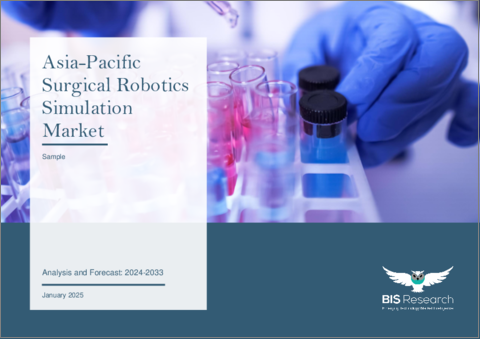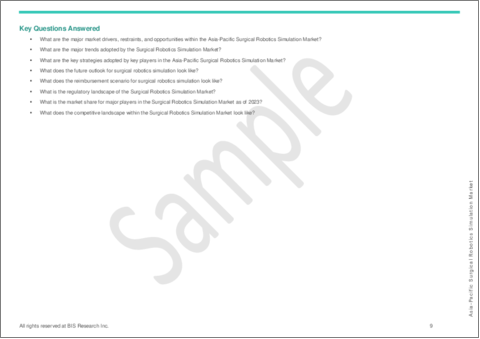|
|
市場調査レポート
商品コード
1643950
アジア太平洋の手術ロボットシミュレーション市場 - 分析と予測(2024年~2033年)Asia-Pacific Surgical Robotics Simulation Market: Analysis and Forecast, 2024-2033 |
||||||
カスタマイズ可能
|
|||||||
| アジア太平洋の手術ロボットシミュレーション市場 - 分析と予測(2024年~2033年) |
|
出版日: 2025年01月29日
発行: BIS Research
ページ情報: 英文 56 Pages
納期: 1~5営業日
|
- 全表示
- 概要
- 図表
- 目次
アジア太平洋の手術ロボットシミュレーションの市場規模は、2024年に8,310万米ドルとなりました。
同市場は、2024年から2033年の予測期間中に19.27%のCAGRで拡大し、2033年には4億560万米ドルに達すると予測されています。手術ロボットシミュレーションは、外科医がバーチャルプラットフォーム上でロボットアシスト手技を練習し、技術と患者の安全性を向上させる最先端技術です。
この市場はアジア太平洋で急速に拡大しています。その背景には、手術ロボットの利用が拡大していること、リスクのないトレーニングが求められていること、手頃な価格のバーチャルリアリティシミュレータが入手可能であることなどがあります。教育機関とロボット企業との提携により、高度なシミュレーションツールの利用可能性が高まっています。手術ロボットシミュレーションは、技術革新とスキル開発に重点を置きながら、この地域全体で手術トレーニングとヘルスケア成果の向上に不可欠なものとなりつつあります。
| 主要市場統計 | |
|---|---|
| 予測期間 | 2024年~2033年 |
| 2024年の評価 | 8,310万米ドル |
| 2033年の予測 | 4億560万米ドル |
| CAGR | 19.27% |
アジア太平洋の手術用ロボットシミュレーション市場は、患者の予後改善と手術トレーニングの向上のために最先端技術を採用するヘルスケアシステムが増えるにつれて急速に拡大しています。外科医はロボット支援手技を手術ロボットシミュレーションでバーチャルに練習することができ、リスクのない現実的なトレーニングで技術を向上させ、医療ミスを減らすことができます。
市場の成長を後押しする主な要因の1つは、アジア太平洋地域全体で手術室での手術ロボットの使用が増加していることです。これらのシステムの使い方を外科医に教えるための効率的なシミュレーションツールの必要性は、その知名度が高まるにつれて高まっています。バーチャルリアリティベースのトレーニングを通じて外科医の能力を向上させることは、特に複雑で危険な手技において、経済的かつ効果的なアプローチであることがわかってきています。
技術の進歩により、実世界の手術状況を正確に模倣した非常に複雑なシミュレーターが製造され、外科医に安全な環境で練習する機会を与えています。シミュレーションツールの導入は、手術用ロボット企業、医療訓練機関、ヘルスケアプロバイダー間の提携によっても加速しています。
アジア太平洋では、手術ロボットシミュレーションを現代のトレーニングプログラムに組み込み、医療業界における技術革新とスキル開発に特に重点を置きながら、手術精度、患者の安全性、ヘルスケア全体の質の向上を推進しています。
当レポートでは、アジア太平洋の手術ロボットシミュレーション市場について調査し、市場の概要とともに、地域別の動向、および市場に参入する企業のプロファイルなどを提供しています。
目次
エグゼクティブサマリー
第1章 アジア太平洋の外科用ロボットシミュレーション市場:概要
第2章 外科用ロボットシミュレーション市場:業界分析
- 規制要件
- 主な動向
- COVID-19が外科用ロボットシミュレーション市場に与える影響
- シミュレーションの利点
- 業界エコシステム
- 投資収益率(ROI)分析
第3章 外科用ロボットシミュレーション市場、地域別
- 地域別概要
- 促進要因と抑制要因
- アジア太平洋
- 地域概要
- 市場促進要因
- 市場抑制要因
- 日本
- 中国
- オーストラリア
- 韓国
- インド
- その他
第4章 外科用ロボットシミュレーション市場:競合ベンチマーキングと企業プロファイル
- 主要戦略と開発
- パートナーシップ、提携、事業拡大
- 資金調達活動
- 新しいサービス
- 合併と買収
- ビジネスモデル
- 直接販売モデル
- リースモデル
- バンドル販売モデル
- 市場シェア分析
- 企業プロファイル
- Vantari VR
第5章 調査手法
List of Figures
- Figure 1: Asia-Pacific Surgical Robotics Simulation Market, $Million, 2024, 2028, and 2033
- Figure 2: Surgical Robotics Simulation Market (by Region), $Million, 2023, 2027, and 2033
- Figure 3: Asia-Pacific Surgical Robotics Simulation Market, $Million, 2023-2033
- Figure 4: Surgical Robotics Simulation Market, Competitive Landscape
- Figure 5: Regulatory Process for Medical Devices in China
- Figure 6: Regulatory Process for Medical Devices in Japan
- Figure 7: Medical Device Classification, Japan
- Figure 8: Digital Ecosystem
- Figure 9: Benefits of Simulation for Surgeons
- Figure 10: Benefits of Simulation for Hospital
- Figure 11: Benefits of Simulation for Patients
- Figure 12: Industry Ecosystem
- Figure 13: Surgical Robotics Simulation Market, Components of Return-on-Investment Analysis
- Figure 14: Benefits of Implementation of Simulation Training
- Figure 15: Asia-Pacific Surgical Robotics Simulation Market, $Million, 2023-2033
- Figure 16: Japan Surgical Robotics Simulation Market, $Million, 2023-2033
- Figure 17: China Surgical Robotics Simulation Market, $Million, 2023-2033
- Figure 18: Australia Surgical Robotics Simulation Market, 2022-2033
- Figure 19: South Korea Surgical Robotics Simulation Market, $Million, 2023-2033
- Figure 20: India Surgical Robotics Simulation Market, $Million, 2023-2033
- Figure 21: Rest-of-Asia-Pacific Surgical Robotics Simulation Market, $Million, 2023-2033
- Figure 22: Partnerships, Alliances, and Business Expansions, January 2021-April 2024
- Figure 23: Funding Activities, January 2021-April 2024
- Figure 24: New Offerings, January 2021-April 2024
- Figure 25: Mergers and Acquisitions, January 2021-April 2024
- Figure 26: Direct Sales Model
- Figure 27: Leasing Model
- Figure 28: Bundle Sales Model
- Figure 29: Surgical Robotics Simulation Market (Product), Company Share, % Share, 2023
- Figure 30: Data Triangulation
- Figure 31: Assumptions and Limitations
List of Tables
- Table 1: Market Snapshot
- Table 2: Surgical Robotics Simulation Market, Market Opportunities
- Table 3: Clinical Utilization of Surgical Robotics Simulator Systems
- Table 4: Surgical Robotics Simulation Market, Future Outlook
- Table 5: Surgical Robotics Simulation Market (by Region), $Million, 2023-2033
- Table 6: Surgical Robotics Simulation Market, Key Development Analysis, January 2021-April 2024
Introduction to Asia-Pacific Surgical Robotics Simulation Market
The Asia-Pacific surgical robotics simulation market was valued at $83.1 million in 2024 and is expected to reach $405.6 million by 2033, growing at a CAGR of 19.27% between the forecast period of 2024-2033. Surgical robotics simulation is a cutting-edge technology that allows surgeons to practice robotic-assisted procedures on a virtual platform, improving their skills and patient safety.
The market is expanding quickly in APAC because of the growing use of surgical robots, the need for risk-free training, and the availability of reasonably priced virtual reality simulators. Partnerships between educational institutions and robotics firms increase the availability of sophisticated simulation tools. Surgical robotics simulation is becoming crucial for improving surgical training and healthcare outcomes throughout the region, with an emphasis on innovation and skill development.
| KEY MARKET STATISTICS | |
|---|---|
| Forecast Period | 2024 - 2033 |
| 2024 Evaluation | $83.1 Million |
| 2033 Forecast | $405.6 Million |
| CAGR | 19.27% |
Market Introduction
The market for surgical robotics simulation in Asia-Pacific is expanding quickly as more and more healthcare systems adopt cutting-edge technologies to improve patient outcomes and surgical training. Surgeons can practice robotic-assisted procedures virtually with surgical robotics simulation, which offers risk-free, realistic training to improve skills and reduce medical errors.
One of the main factors propelling the market's growth is the increasing use of surgical robots in operating rooms throughout the APAC region. The need for efficient simulation tools to teach surgeons how to use these systems is growing as they become more well-known. Enhancing surgeon competency through virtual reality-based training is turning out to be an economical and effective approach, especially for intricate and dangerous procedures.
Advances in technology have produced extremely complex simulators that accurately mimic real-world surgical situations, giving surgeons the opportunity to practice in a safe setting. The region's adoption of simulation tools is also being accelerated by partnerships among surgical robotics companies, medical training institutions, and healthcare providers.
The APAC region is incorporating surgical robotics simulation into contemporary training programs, promoting advancements in surgical precision, patient safety, and overall healthcare quality, with a particular emphasis on innovation and skill development in the healthcare industry.
Market Segmentation:
Segmentation 1: by Region
- Asia-Pacific
- Japan
- India
- China
- South Korea
- Australia
- Rest-of-Asia-Pacific
How can this report add value to an organization?
Growth/Marketing Strategy: Partnerships, alliances, funding, new offerings, and business expansions together accounted for the maximum number of key developments of the total developments in the Asia-Pacific surgical robotics simulation market.
Competitive Strategy: The APAC surgical robotics simulation market is highly fragmented, with few public and many private companies. Key players in the Asia-Pacific surgical robotics simulation market analyzed and profiled in the study involve established players that offer various kinds of products and services.
Table of Contents
Executive Summary
Scope and Definition
1 Asia-Pacific Surgical Robotics Simulation Market: Overview
- 1.1 Key Findings
- 1.1.1 Market Growth
- 1.1.2 Competitive Landscape
- 1.1.3 Clinical Utilization
- 1.1.4 Future Outlook
2 Surgical Robotics Simulation Market: Industry Analysis
- 2.1 Regulatory Requirements
- 2.1.1 Regulations and Policies for Surgical Robotic Systems
- 2.1.1.1 China
- 2.1.1.2 Japan
- 2.1.2 Recommended Guidelines for the Development and Practice of Surgical Simulation
- 2.1.2.1 Rest-of-the-World
- 2.1.1 Regulations and Policies for Surgical Robotic Systems
- 2.2 Key Trends
- 2.2.1 Digital Ecosystem
- 2.2.2 Telesurgery and Remote Surgery
- 2.2.3 AR/VR Systems
- 2.2.4 Surgical Robots
- 2.3 Impact of COVID-19 on the Surgical Robotics Simulation Market
- 2.3.1 COVID-19 Impact on Surgical Training Education
- 2.3.2 COVID-19 Impact on Surgical Robotics Simulator Manufacturers
- 2.4 Benefits of Simulation
- 2.4.1 Surgeon Benefits
- 2.4.2 Hospital Benefits
- 2.4.3 Patient Benefits
- 2.5 Industry Ecosystem
- 2.6 Return on Investment (ROI) Analysis
3 Surgical Robotics Simulation Market (By Region)
- 3.1 Regional Summary
- 3.2 Drivers and Restraints
- 3.3 Asia-Pacific
- 3.3.1 Regional Overview
- 3.3.2 Driving Factors for Market Growth
- 3.3.3 Factors Challenging the Market
- 3.3.4 Japan
- 3.3.5 China
- 3.3.6 Australia
- 3.3.7 South Korea
- 3.3.8 India
- 3.3.9 Rest-of-Asia-Pacific
4 Surgical Robotics Simulation Market: Competitive Benchmarking and Company Profile
- 4.1 Key Strategies and Development
- 4.1.1 Partnerships, Alliances, and Business Expansions
- 4.1.2 Funding Activities
- 4.1.3 New Offerings
- 4.1.4 Mergers and Acquisitions
- 4.2 Business Model
- 4.2.1 Direct Sales Model
- 4.2.2 Leasing Model
- 4.2.3 Bundle Sales Model
- 4.3 Market Share Analysis
- 4.4 Company Profiles
- 4.4.1 Vantari VR
5 Research Methodology
- 5.1 Data Sources
- 5.1.1 Primary Data Sources
- 5.1.2 Secondary Data Sources
- 5.1.3 Data Triangulation






